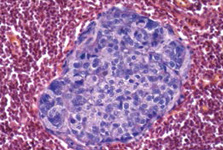Understanding the spread of breast cancer
 Mutations can reveal which breast cancer tumours are more likely to spread to other parts of the body, and which ones won’t.
Mutations can reveal which breast cancer tumours are more likely to spread to other parts of the body, and which ones won’t.
Peter Rogan, PhD, professor in Biochemistry, and Computer Science, is using unique analysis software that looks at a specific type of mutation— a splicing mutation. Previous studies of 445 tumours detected 429 splicing mutations, compared with the analysis software that found more than 5,000.
Combining the software with human tumour tissue sample genetic data, the research team discovered that mutations in the neural cell adhesion molecule and other related genes were present at a higher rate in tumours that had metastasized to the lymph nodes versus ones that did not.
“One of the big issues in breast oncology is that women are sometimes treated with chemotherapy even if their tumour isn’t going to metastasize,” said Rogan. “The ideal situation would be to identify those patients where the side-effects and negative consequences of chemotherapy following surgery can be avoided, or at least minimized.”








